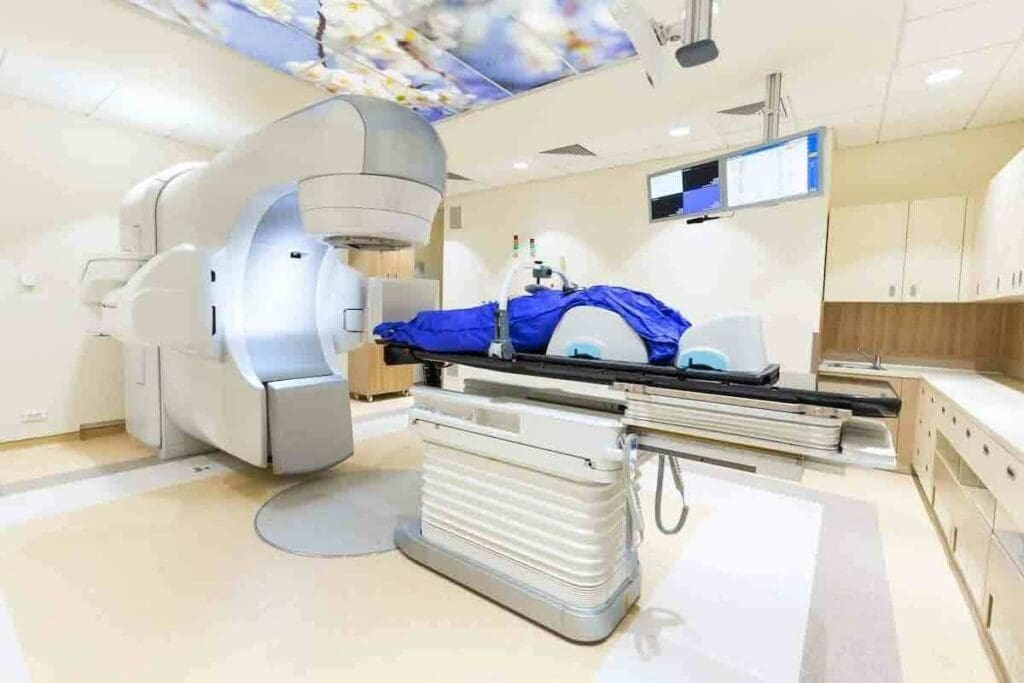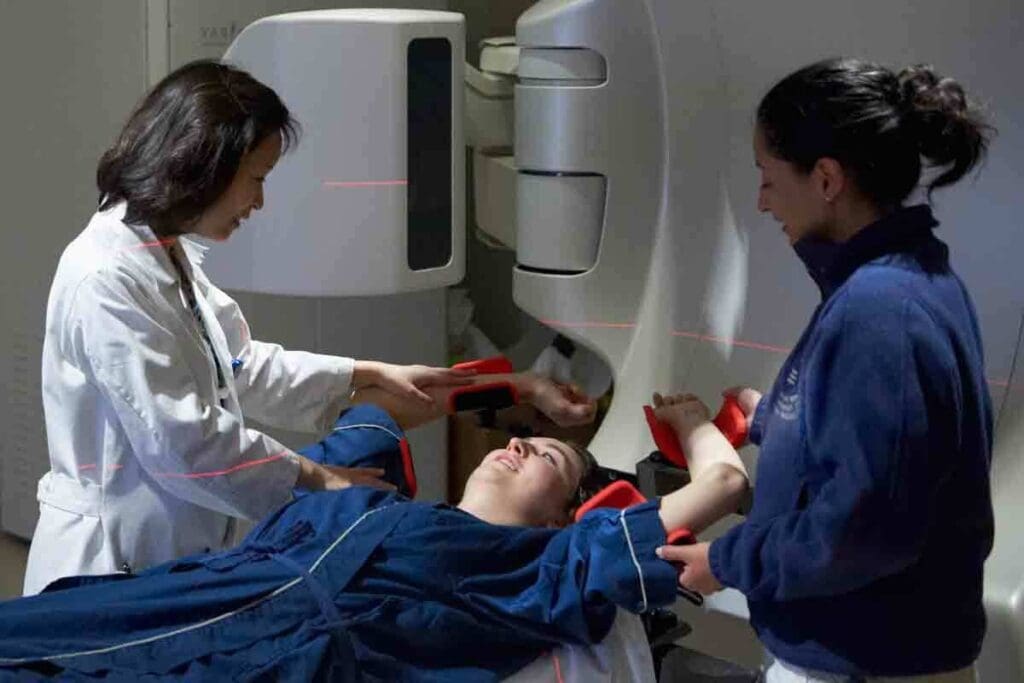Last Updated on November 27, 2025 by Bilal Hasdemir

At Liv Hospital, we know that radiation therapy can be scary. It’s important for patients to know how often they’ll get treatments. This helps them make good choices and get the best results.
Radiation treatments are given once a day, every weekday, for weeks. How often depends on the cancer type, its stage, and the patient’s health. Our team helps patients through this, making sure they get the best care.
Most people get radiation therapy every weekday for 5 to 8 weeks. This lets normal cells rest on weekends. It helps the treatment work better.
Key Takeaways
- Radiation treatments are usually given once daily, five days a week.
- The frequency depends on the type and stage of cancer, as well as the patient’s health.
- Treatment duration typically ranges from 5 to 8 weeks.
- Weekend breaks allow normal cells to recover.
- Liv Hospital provides complete support and guidance throughout the treatment process.
Understanding Radiation Therapy Basics

Learning about radiation therapy is key for those starting cancer treatment. It’s a treatment that uses high-energy rays to kill cancer cells. At Liv Hospital, we offer personalized help and support during treatment.
What Is Radiation Therapy?
Radiation therapy, or radiotherapy, uses high-energy particles to kill cancer cells. It damages the DNA of cancer cells, stopping them from growing. This treatment targets the specific area of the body with cancer.
Types of Radiation Treatments
There are two main types of radiation therapy: external beam radiation therapy (EBRT) and internal radiation therapy.
- External Beam Radiation Therapy (EBRT): This is the most common type, where radiation is delivered from a machine outside the body.
- Internal Radiation Therapy: Also known as brachytherapy, this involves placing radioactive material directly inside or near the tumor.
Each type has its own uses and benefits. The choice depends on the cancer type and stage, among other factors.
How Radiation Therapy Works
Radiation therapy delivers high-energy rays to cancer cells. These rays damage the DNA, stopping cancer cells from growing. The goal is to target the tumor while protecting healthy tissues.
Treatment schedules vary among patients. Treatments are usually given 5 days a week for several weeks. The number of sessions can range from 15 to 30, depending on the cancer and treatment plan. Newer methods, like hypofractionation, offer fewer but higher-dose treatments.
Standard Frequency of Radiation Treatments

The frequency of radiation treatments changes based on several factors. These include the type and stage of cancer. We make sure each patient gets a treatment plan that fits their unique situation.
The Five-Day Weekly Schedule
Most people get external beam radiation therapy once a day, five days a week. This schedule helps healthy cells recover between treatments. It reduces side effects.
The total dose of radiation is split into smaller fractions. This makes treatment more manageable and safer for healthy tissues.
Why Treatments Are Spread Out
Spreading out radiation treatments over weeks helps healthy cells recover. This approach lessens side effects and makes treatment more bearable. Our team at Liv Hospital works with patients to manage side effects and keep them on track with treatment.
Variations in Treatment Schedules
While the five-day weekly schedule is common, it can change. The type of cancer, its stage, and the patient’s health all play a role. Some patients might get radiation therapy more than once a day, or fewer than five days a week.
We tailor treatment plans to each patient’s needs. This ensures they get the best care possible.
Key considerations for treatment schedules include:
- The type and stage of cancer
- The patient’s overall health and response to treatment
- The goal of the treatment (curative vs. palliative)
- The total dose of radiation required
By planning and adjusting treatment schedules carefully, we aim to make radiation therapy effective. We also aim to minimize its impact on the patient’s quality of life.
How Often Do You Have Radiation Treatments?
Radiation treatment frequency changes based on several factors. These include the type and stage of cancer. At Liv Hospital, we make treatment plans that fit each patient’s unique situation.
Typical Treatment Schedules
The schedule for radiation treatments varies a lot. For example, breast cancer patients usually get 15-30 fractions over three to five weeks. This helps deliver the right dose of radiation while keeping side effects low.
Other cancers might need different schedules. Our team works with each patient to find the best plan. We consider the cancer’s size, location, and type, and the patient’s health.
Factors That Determine Treatment Frequency
Several things affect how often radiation treatments happen. These include:
- The type and stage of cancer
- The size and location of the tumor
- The patient’s overall health and medical history
We use these factors to make a treatment plan that works best for each patient.
Customizing Treatment Plans
At Liv Hospital, we focus on customized treatment plans for each patient. Our team works together to find the best schedule. This ensures patients get the right amount of radiation at the right time.
By tailoring plans to each patient, we aim to improve outcomes and quality of life. We adjust treatment frequencies and add other therapies as needed. Our goal is to provide complete care that addresses all aspects of a patient’s health.
Radiation Treatment Schedules by Cancer Type
Different cancers need different radiation treatment plans. At Liv Hospital, we tailor our treatments for each patient. This ensures they get the best care possible.
Breast Cancer: 15-30 Fractions Over 3-5 Weeks
For breast cancer, radiation is given in 15 to 30 fractions. This is over three to five weeks. It helps deliver the right dose of radiation with fewer side effects.
The exact number of fractions depends on the cancer’s stage. It also depends on whether the patient had a lumpectomy or mastectomy.
Prostate Cancer Radiation Protocols
Prostate cancer treatment plans vary. Some patients get treatment for weeks, while others might get it in a shorter time, called hypofractionation. The choice depends on the cancer’s stage and the patient’s health.
Head and Neck Cancer Treatment Frequency
Head and neck cancer treatment is more intense. Radiation is given daily, Monday through Friday, for several weeks. This aims to kill cancer cells while saving healthy tissue.
Lung Cancer Radiation Schedules
Lung cancer treatment plans differ based on the type of cancer. Non-small cell lung cancer might get conventional treatment, while small cell lung cancer might get SBRT. SBRT uses higher doses in fewer fractions.
It’s important to note that radiation therapy can be repeated if needed. But each repeat is carefully considered to avoid harmful side effects. Our team at Liv Hospital works with each patient to find the best treatment plan.
Duration of Radiation Treatment Courses
Knowing how long radiation treatment lasts is key for those fighting cancer. At Liv Hospital, we see that every patient’s path is different. The time needed for radiation treatment can change a lot.
Typical Length of Treatment Plans
The total radiation dose is split into smaller parts called fractions. Treatment can take weeks. Each session usually lasts 10 to 20 minutes.
The length of your treatment depends on your cancer type and stage, and your health.
Factors influencing treatment duration include:
- The type and stage of cancer
- Treatment goals (curative vs. palliative)
- Patient’s overall health and response to treatment
Factors That Determine Treatment Duration
Many things affect how long radiation treatment lasts. These include the cancer type, its stage, and your health. Our team at Liv Hospital customizes treatment plans for each patient.
Short-Course vs. Long-Course Radiation
We provide both short-course and long-course radiation therapy. Short-course gives higher doses in a shorter time. Long-course spreads treatment over longer periods with lower doses.
| Treatment Type | Duration | Dose per Fraction |
| Short-Course Radiation | 1-2 weeks | Higher dose |
| Long-Course Radiation | 3-7 weeks | Lower dose |
Our team will help choose the best treatment for you. We aim to give you the care that fits your needs.
Length of Individual Radiation Sessions
Each radiation session is short, even though treatment plans can last weeks. Knowing what to expect can help reduce anxiety. It makes the treatment smoother for our patients.
What Happens During a 10-20 Minute Session
A typical session lasts 10 to 20 minutes. The treatment itself is painless and quick. The rest of the time is for preparation and ensuring the treatment area is targeted correctly.
Our team positions you on the treatment table and adjusts the equipment. This is based on your personalized treatment plan. The actual radiation delivery is a brief part of the session. We aim to make the process comfortable and efficient.
Preparation Time vs. Treatment Time
Most of the session is spent on preparation. This includes positioning the patient and adjusting the machine. The actual treatment is very short, often just a few minutes.
Our team works hard to ensure you are comfortable. They also make sure the treatment is delivered accurately.
Factors That Affect Session Length
Several factors can affect session length. These include the treatment plan’s complexity, the type of radiation therapy, and the patient’s needs. For example, treatments that need precise targeting may take longer to prepare.
We customize each session to meet our patients’ specific needs. We aim to balance efficiency with the need for precise and effective treatment. The number of rounds varies based on the cancer type and stage, and the treatment goals.
Understanding these factors helps patients prepare better for their sessions. We’re committed to providing care that is effective and respectful of our patients’ time and comfort.
Hypofractionated Radiation: Fewer, Higher-Dose Treatments
Hypofractionated radiation is a new way to give more radiation in fewer visits. It’s gaining popularity for making treatment easier and shorter.
What Is Hypofractionation?
Hypofractionation means giving more radiation in a shorter time than usual. It aims to keep treatment effective but with fewer trips to the doctor.
Benefits of Fewer Treatment Sessions
This method is great because it means fewer visits to the doctor. It’s perfect for those with tight schedules or who travel far. It can also save money and make things easier for patients.
Candidates for Hypofractionated Therapy
Not everyone can get hypofractionated radiation. Doctors look at the cancer type, stage, and patient health. Our team decides if it’s right for each patient.
Ultra-Hypofractionation Approaches
Ultra-hypofractionation is even more intense, with just a few high-dose treatments. It’s being tested for some cancers and might offer big benefits.
We’re dedicated to the latest treatments at our institution. Hypofractionated radiation is one of them. We work with patients to find the best treatment for them.
Maximum Number of Radiation Treatments
The number of radiation treatments a patient can get varies. It depends on the cancer type, its stage, where the tumor is, and the patient’s health. At Liv Hospital, we look at these factors to find the best treatment plan. We aim to protect healthy tissues as much as possible.
Tissue Tolerance Limitations
When deciding on radiation treatments, we consider how tissues can handle radiation. Some tissues, like the liver and kidneys, can only take so much.
Tissue tolerance is key in planning radiation therapy. We use advanced imaging and systems to target the tumor precisely. This helps protect healthy tissues around it.
How Maximum Doses Are Calculated
Figuring out the maximum radiation dose is complex. We use special software to simulate how radiation will affect the tumor and healthy tissues. This helps us optimize the treatment plan to hit the tumor hard while keeping healthy tissues safe.
Radiation oncologists aim to give the tumor the highest dose possible. But they must also protect normal tissues. This balance is essential for treatment success.
Balancing Efficacy and Safety
It’s a challenge to balance how well radiation therapy works with how safe it is. We aim to give the right dose to treat cancer without causing too many side effects. This requires careful planning and monitoring during treatment.
“The key to successful radiation therapy lies in its precision and the ability to tailor the treatment to the individual patient’s needs.”
Technological Advances Affecting Treatment Limits
New technology in radiation therapy has changed treatment limits. Techniques like IMRT and SBRT allow for more precise radiation delivery. These advancements help us treat tumors better while reducing harm to healthy tissues.
At Liv Hospital, we keep up with the latest in radiation therapy technology. This helps us give our patients the best care possible.
Can You Receive Radiation Therapy More Than Once?
Radiation therapy can sometimes be given more than once. But this choice depends on each patient’s situation. At Liv Hospital, we carefully look at each case to decide the best treatment.
Considerations for Repeat Radiation
Several factors are considered when deciding on repeat radiation therapy. These include the cancer type and location, the first radiation dose, and the patient’s health.
Key considerations include:
- The time elapsed after the first radiation therapy
- The total radiation dose the patient has received
- The benefits versus the risks of more radiation
Time Intervals Between Courses
The gap between radiation therapy sessions is important. Longer gaps help the body recover better. “The time between treatments allows for some recovery of the normal tissues,” says A medical expert, a radiation oncologist. “But, we must also think about the risk of cancer coming back.”
Cumulative Radiation Exposure Risks
High doses of radiation over time can harm. It can lead to side effects and even secondary cancers. We use advanced tech to protect healthy tissues.
It’s a delicate balance between fighting cancer and avoiding harm from too much radiation.
Alternative Approaches After Previous Radiation
For some, other treatments might be better after radiation. These could be surgery, chemotherapy, or targeted therapies. “We always look for the most effective treatment strategy tailored to the individual patient’s needs,” says a Medical consultant, stressing the importance of personalized care.
At Liv Hospital, our team works together to offer the best care. We discuss all options to ensure the best outcome for our patients.
Conclusion: Success Rates and What to Expect
Radiation therapy is a top choice for treating many cancers. Its success rate depends on the cancer type and stage. At Liv Hospital, we aim to offer the best radiation therapy with high success rates.
Understanding what to expect from radiation therapy is key. We tailor treatment plans to fit each patient’s needs. This ensures they get the best care possible.
Many factors affect the success rate of radiation therapy. These include the cancer type and stage. We use the latest technology and expertise to boost success rates and reduce side effects. Our goal is to provide full care and support during treatment.
FAQ
How often do you get radiation treatments?
Radiation treatments are given once a day, five days a week. This goes on for weeks. The exact schedule depends on the cancer type, its stage, and your health.
What is the standard frequency of radiation treatments?
The usual schedule is once a day, five days a week. This helps healthy cells recover, reducing side effects.
How long is radiation therapy?
Radiation therapy’s length varies. It depends on the cancer type and stage. Treatments can last from weeks to months.
Can you have radiation therapy more than once?
Getting radiation therapy more than once is possible. It depends on the cancer type, location, and your health. Our team will decide the best treatment for you.
What is the maximum number of radiation treatments?
The maximum treatments depend on several factors. These include tissue limits and balancing safety and effectiveness. We use advanced tech to ensure precise and safe therapy.
How many rounds of radiation are normal?
The number of treatments varies by cancer type and stage. For example, breast cancer patients might get 15-30 sessions over three to five weeks.
What is the success rate of radiation therapy?
Radiation therapy is very effective against cancer. At Liv Hospital, we aim to provide top-notch therapy with personalized care.
How long is a session of radiotherapy?
Radiotherapy sessions are short and comfortable. They usually last 10-20 minutes. Our team will make sure you’re comfortable and informed.
Can you have radiotherapy more than once?
Getting radiotherapy more than once is possible. It depends on the cancer type, location, and your health. Our team will decide the best treatment for you.
What is hypofractionated radiation therapy?
Hypofractionated radiation therapy delivers higher doses in fewer sessions. We offer this option for eligible patients.
References
- Baskar, R., Lee, K. A., Yeo, R., & Yeoh, K. W. (2012). Cancer and radiation therapy: Current advances and future directions. International Journal of Medical Sciences, 9(3), 193-199. https://pmc.ncbi.nlm.nih.gov/articles/PMC3298009/






